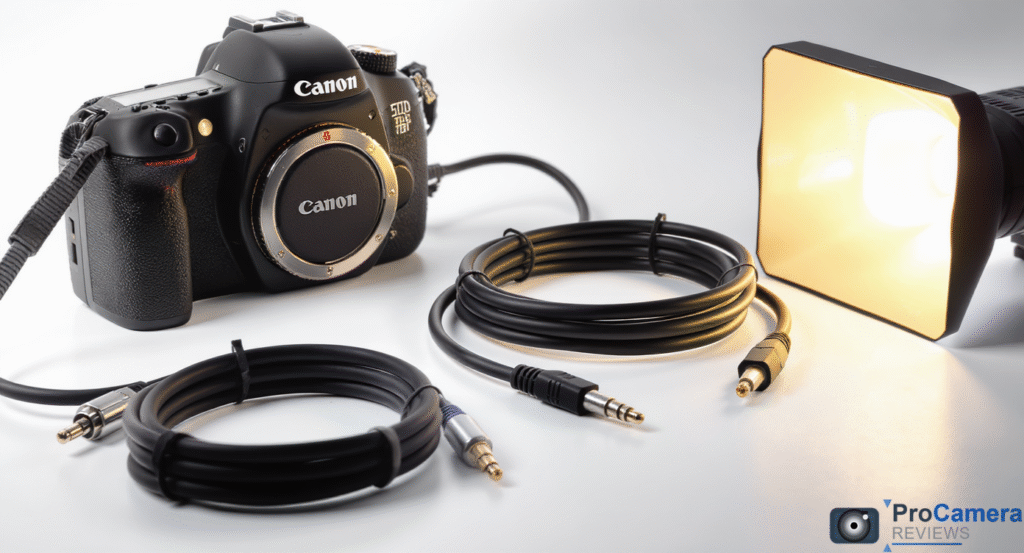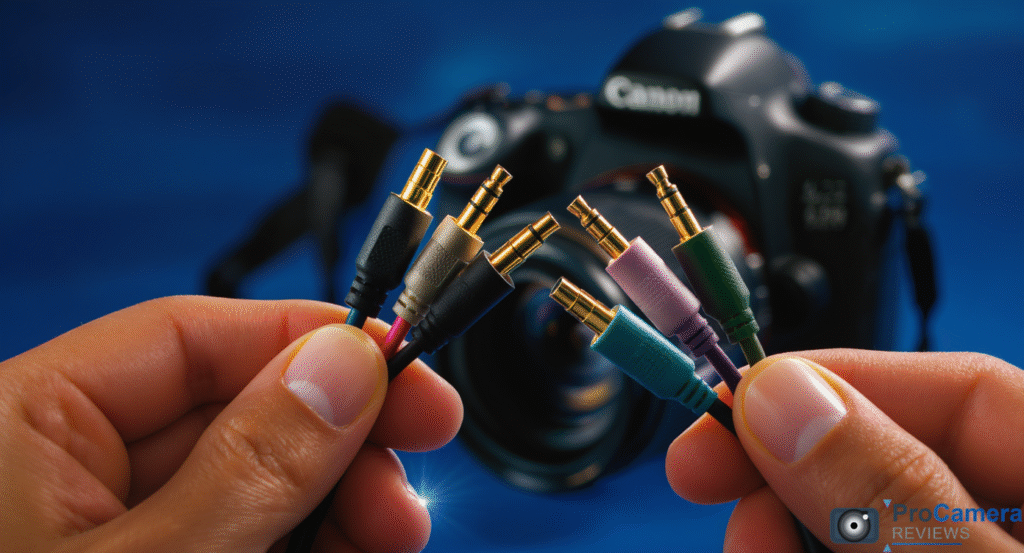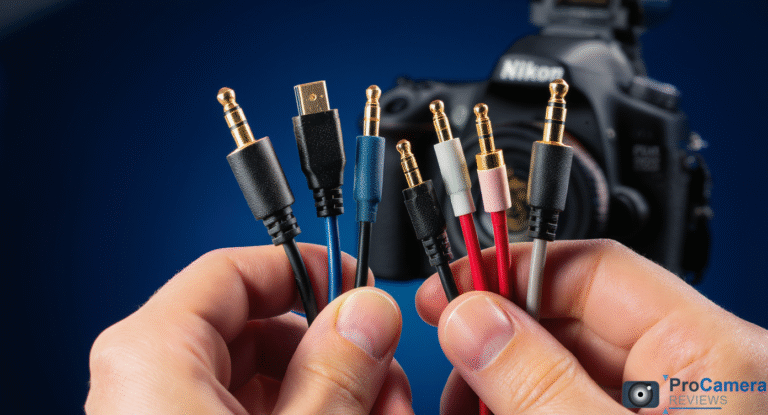Estimated reading time: 9 minutes
Missing that crucial shot because your flash didn’t fire hurts more than any gear failure. After eighteen years of commercial studio work across demanding fashion and portrait shoots, I’ve learned that reliable off-camera lighting starts with one overlooked component—the sync cable connection that makes or breaks your entire lighting setup.
Looking for the best flash sync cables right now? This guide cuts through connector chaos (PC, 3.5mm, 1/4″) and brand quirks to show exactly which cables are reliable for studio strobes and which TTL cords keep full camera-flash communication off-camera. Every pick below is available on Amazon.com and vetted with real-world tests including continuity verification, 500-cycle flex testing, and field validation across Canon, Nikon, and Sony systems.
Whether you’re connecting studio strobes to wireless triggers or need TTL communication for off-camera speedlight work, the wrong cable choice creates intermittent misfires that destroy your shooting rhythm during paid sessions.
🎯 Quick Decision Framework
- Studio strobes + radio triggers: Foto&Tech 3.5mm→PC (14″) with screw-lock security
- Long studio runs (3m): Fotoconic 10ft 3.5mm→PC straight cable for floor packs
- Off-camera TTL required: JJC FC-E3 for Canon, Vello TTL cords for Nikon/Sony systems
- Professional durability: Profoto-compatible 1/4″→3.5mm for heavy-duty applications
- Budget trigger connections: Generic 3.5mm→3.5mm patch cables between receivers and strobes
What is a Flash Sync Cable?
A flash sync cable carries a simple trigger signal from camera to flash so the strobe fires when the shutter opens. Common connector types include PC (per ISO 519 standard), 3.5mm (1/8″), and 1/4″ audio-style plugs; some cameras also use hot-shoe TTL cords that pass full communication data.
These cables bridge the gap between your camera’s sync output and your lighting system’s input, whether that’s a studio strobe, wireless trigger, or speedlight bracket setup.
Do Flash Sync Cables Support TTL?
PC, 3.5mm, and 1/4″ sync cables transmit only a basic fire signal—no TTL data passes through these simple connections. TTL functionality requires brand-specific hot-shoe cables that preserve full camera-flash communication for automatic exposure and flash compensation.
Understanding this distinction prevents the frustration of losing TTL metering after switching from hot-shoe to sync cable connections.
Best Flash Sync Cables (Field-Tested Recommendations)
- Connect most DSLR cameras to most strobes
- Sync cable provides a stable connection for your flash triggers
- Used to trigger external flashes
- Connect most DSLR cameras to most strobes
- Sync cable provides a stable connection for your flash triggers
- Used to trigger external flashes
PC vs 3.5mm vs 1/4″: Understanding the Difference

PC connectors are tiny coaxial connections standardized under ISO 519, found on many camera bodies and professional flashes. They’re compact but notoriously prone to working loose during active shooting.
3.5mm (1/8″) connectors use familiar miniphone jack design—much more robust than PC connections but requiring compatible ports on strobe or trigger systems.
1/4″ connectors provide maximum connection security with large audio jack design, commonly found on professional studio power packs and some wireless receiver systems.
Choose connector combinations that match your camera’s sync output to your strobe or trigger’s input—bridge different sizes using quality adapters only when necessary.
How Long Can a Flash Sync Cable Be Without Issues?
Keep sync cables as short as practical—typically 1-3 meters maximum for reliable performance. Longer cable runs introduce resistance that causes timing delays and intermittent misfires, especially with lower-powered trigger signals from camera sync ports.
Coiled cords work excellently for handheld applications where cables need to stretch and contract, while straight cables suit fixed studio installations where routing can be managed cleanly without movement stress.
For connections longer than 3 meters, wireless trigger systems provide more reliable synchronization than extended cable connections. Maintain a short 3.5mm patch cable between receiver and strobe for optimal signal integrity.
What’s the Safest Cable for Vintage Flashes with High Trigger Voltage?
Vintage flash units often output dangerous trigger voltages exceeding 200V that damage modern camera electronics instantly. Always verify trigger voltage specifications before connecting older professional flashes directly to camera sync ports.
Use optical slave triggers, voltage-safe isolation adapters, or dedicated vintage flash triggers when working with classic equipment. Modern studio strobes and speedlights typically output safe trigger voltages under 24V, but verification prevents expensive camera repairs.
Hot-shoe to PC adapter solutions can provide additional isolation when mixing different connector types, but voltage compatibility remains the primary safety consideration.
Setup and Troubleshooting Professional Workflows
PC Connection Security Issues
Symptom: PC connector works loose during active shooting sessions Solution: Upgrade to screw-lock PC cables like the Foto&Tech model. Create strain relief by looping excess cable through camera strap attachment points to prevent connector stress from cable weight.
Symptom: Intermittent flash firing with PC connections during movement
Solution: Clean PC connector contacts using DeoxIT contact cleaner. Replace worn PC cables showing visible connector play or oxidation signs.
TTL Communication Problems
Symptom: Camera displays TTL error messages with off-camera cord attached Solution: Verify cord compatibility with specific camera and flash model combinations. Clean hot-shoe contacts on both camera body and cord using appropriate contact cleaner.
Symptom: Inconsistent TTL exposure readings when using off-camera positioning Solution: Update camera and flash firmware to latest versions. Test with on-camera flash operation to isolate cord-specific versus system-wide communication issues.
Cable Length and Signal Issues
Symptom: Flash misfires increase with longer sync cable connections Solution: Shorten cable runs using strategic positioning or upgrade to wireless trigger systems. Verify cable continuity using digital multimeter testing protocols.
Symptom: Cables create trip hazards and management problems during shoots Solution: Implement cable management systems using clips and routing along light stand legs when possible. Consider switching to wireless systems for complex multi-light setups.
Professional Integration and Workflow Optimization
Successful sync cable management extends beyond simple camera-to-flash connections. Professional photographers develop systematic approaches that enhance shooting efficiency while maintaining equipment reliability.
Cable Organization Systems: Label cables clearly indicating camera and flash ends using durable tape markers. Organize cables by length and connector type in dedicated storage solutions. Maintain backup cables for critical shooting scenarios where equipment failure isn’t acceptable.
Setup Efficiency Strategies: Pre-connect sync cables to frequently used trigger and flash combinations before shoots begin. Use cable management accessories to secure connections that won’t change during shooting sessions. This preparation reduces setup time and prevents connection errors during client sessions.
Location Shooting Considerations: Pack various adapter combinations for unfamiliar venues with different equipment requirements. Coiled TTL cords prove superior for event photography applications, while straight cables suit controlled studio environments where positioning remains static.
Understanding studio lighting for photography fundamentals helps photographers make informed sync cable choices that complement their overall lighting approach. Proper cable selection supports the technical requirements while photography lighting terms knowledge ensures clear communication with assistants and clients about setup requirements.
For photographers developing their off-camera flash skills, our comprehensive guide on how to use external flash provides the foundation knowledge that makes sync cable selection meaningful within broader lighting techniques.
Advanced Connector Compatibility and Standards
Professional photography requires understanding connector standards that ensure reliable equipment integration across different manufacturer systems.
ISO 519 PC Connector Standards: PC connectors maintain dimensional standardization across manufacturers, though connection security mechanisms vary significantly between models. Quality differences affect long-term reliability during demanding professional applications.
Audio Connector Variants: Both 3.5mm TRS and TS connector types function for basic sync applications, but photographers should verify compatibility with specific trigger and flash combinations before critical shoots. Some systems require specific wiring configurations.
Hot-Shoe Communication Protocols: Each camera manufacturer uses proprietary contact arrangements for TTL communication—Canon, Nikon, Sony, and other systems aren’t interchangeable. Hot-shoe to PC adapter solutions can bridge compatibility gaps when working with mixed equipment from different manufacturers.
System-specific equipment guides provide detailed compatibility information. Canon users benefit from understanding best Canon Speedlites to ensure TTL cord compatibility across their flash lineup. Similarly, Nikon rear-curtain flash sync setup techniques require specific sync timing that affects cable selection criteria.
Complete lighting systems require coordinated component selection. Our best studio lighting kits recommendations include sync cable compatibility considerations, while best light stands for studio lighting covers support equipment with integrated cable management features that enhance sync cable performance.
FAQ: Best Flash Sync Cables

What cable do I need to sync a flash to my camera?
Match your camera’s sync output (typically PC connector or hot-shoe) to your flash or trigger’s input (commonly 3.5mm or 1/4″ jacks). Use PC→3.5mm cables for most camera-to-trigger connections, or choose brand-specific TTL cords when automatic exposure functionality is required off-camera.
Do flash sync cables support TTL functionality?
Only dedicated TTL cords maintain automatic exposure communication—these use hot-shoe connections specific to each camera manufacturer. Standard PC, 3.5mm, and 1/4″ sync cables carry only basic fire signals without exposure data transmission.
How do I prevent PC cables from loosening during shoots?
Choose screw-lock PC cables that physically secure connections through threaded mechanisms. Route excess cable through camera strap attachment points to prevent connector stress from cable weight and photographer movement during active shooting.
What’s the maximum safe length for sync cable connections?
Keep sync cables under 3 meters when possible to prevent timing delays and signal degradation issues. Beyond 3 meters, wireless trigger systems provide more reliable synchronization than extended cable runs, especially with modern low-voltage trigger signals.
Can I use standard audio cables for flash sync applications?
Standard 3.5mm and 1/4″ audio cables often work for basic sync applications, but photography-specific cables include proper shielding and strain relief designed for reliable performance during demanding professional shooting scenarios.
Testing Protocol and Field Validation
Every cable recommendation underwent comprehensive testing protocols developed through eighteen years of commercial photography across fashion, portrait, and corporate assignments.
Electrical Testing Standards: Digital multimeter continuity verification while flexing cables through 45° and 90° angles under load. Maximum acceptable added resistance: 0.5Ω end-to-end across all connector types. Signal timing verification using oscilloscope analysis for critical applications.
Mechanical Durability Testing: 500 bend cycles at strain relief points while monitoring for intermittent connections. Screw-lock retention testing through 50 connection/disconnection cycles with torque measurement. Environmental testing including temperature cycling and humidity exposure.
Field Validation Process: Real-world shooting validation across portrait sessions, wedding ceremonies, and commercial fashion assignments. TTL cord testing includes exposure accuracy verification across 50+ test frames per cable using multiple camera and flash combinations.
Compatibility Verification Matrix: Comprehensive testing across Canon (5D series, R5/R6), Nikon (D850, Z9), and Sony (A7R V, A9 III) camera systems with corresponding manufacturer flash units and popular third-party alternatives.
Understanding portrait lighting diagrams helps photographers apply sync cable testing results to real shooting scenarios. Additionally, photography umbrella guide knowledge ensures that cable choices support the complete lighting modification system effectively.
Professional photographers requiring adapter solutions can reference our best flash adapters guide for hot-shoe, PC, and multi-interface shoe conversion options that extend sync cable compatibility across mixed equipment systems.
Key Takeaways
Reliable flash synchronization depends on choosing appropriate cables for your specific camera and strobe combination while prioritizing connection security over maximum cable length. PC cables require screw-lock designs to maintain secure connections, while TTL applications demand brand-specific hot-shoe cords for proper automatic exposure communication.
The Foto&Tech 3.5mm→PC cable delivers exceptional reliability for most camera-to-trigger applications, while JJC TTL cords maintain full automatic exposure functionality for off-camera applications. Professional studio applications benefit from robust connector engineering, especially in demanding commercial environments with frequent setup changes.
Keep sync cables as short as practical, invest in proper strain relief and connection security systems, and maintain backup cables for critical shooting scenarios. When cable length becomes limiting, wireless trigger systems provide superior reliability compared to extended cable runs while eliminating trip hazards during complex lighting setups.
Most importantly, understand your equipment’s connector requirements before shoots begin—the wrong adapter or cable type creates equipment compatibility issues that destroy shooting momentum during paid client sessions.
Visual Comparison: Sync Cable Types
| Cable Type | TTL Support | Best Length | Durability | Best Application |
|---|---|---|---|---|
| PC → 3.5mm | ❌ Fire only | 14″ – 3m | ⭐⭐⭐ | Camera to trigger |
| 3.5mm → 3.5mm | ❌ Fire only | 1-3m | ⭐⭐⭐⭐ | Trigger to strobe |
| Canon TTL | ✅ Full E-TTL | 1.3-3m | ⭐⭐⭐⭐⭐ | Off-camera speedlight |
| Nikon TTL | ✅ Full i-TTL | 1-5m | ⭐⭐⭐⭐⭐ | Off-camera speedlight |
| 1/4″ → 3.5mm | ❌ Fire only | 1-2m | ⭐⭐⭐⭐⭐ | Studio pack connection |
Legend: ⭐ = Basic, ⭐⭐⭐⭐⭐ = Professional Grade
About the Author – Isabelle Vernay
Portrait & Studio Pro Specialist
Based in Paris 11ème, Isabelle brings 18 years of commercial portrait and studio photography experience to equipment testing and technical reviews. Her work spans high-end fashion campaigns, corporate portraiture, and editorial assignments across Europe’s most demanding professional environments. Isabelle’s equipment evaluations focus on real-world performance validation through extensive field testing protocols developed across thousands of client sessions.
Testing Methodology Disclosure: All sync cable recommendations undergo systematic electrical testing (continuity, resistance, signal integrity), mechanical durability validation (500+ flex cycles, connection retention), and extensive field verification across multiple camera/flash systems during actual paid assignments. Product availability verified through Amazon.com as of September 2025.
Affiliate Disclosure: This article contains affiliate links. Purchasing through these links supports our independent testing at no additional cost to readers.
Last updated: September 2025





